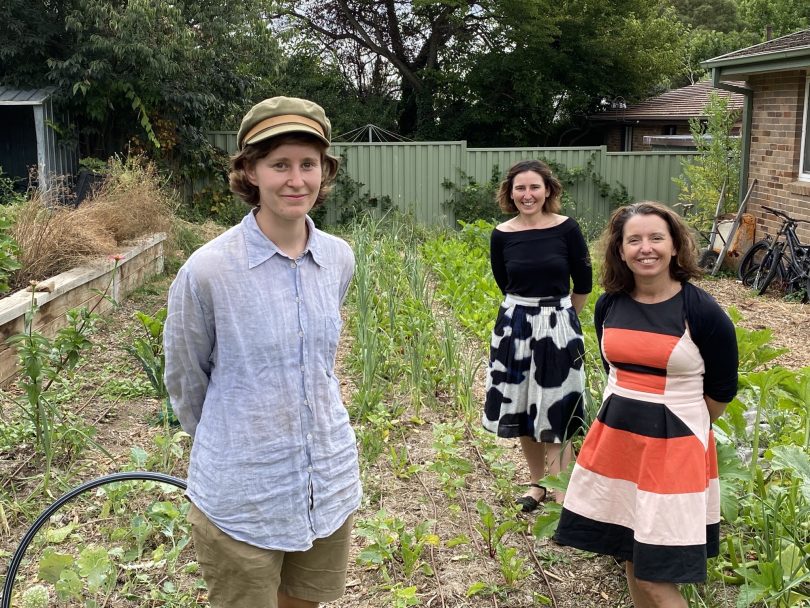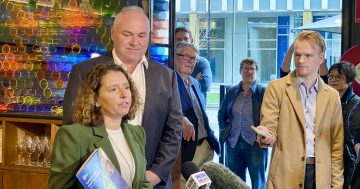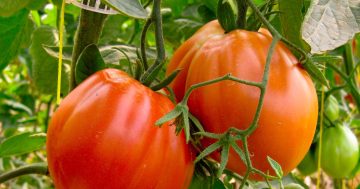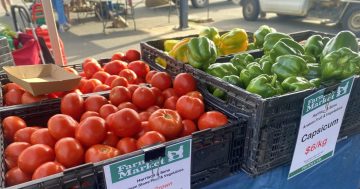
Karina Vennonen of the Patchwork Urban Farm Project, University of Canberra Associate Professor Bethaney Turner and Minister for the Environment Rebecca Vassarotti in the midst of a bountiful local harvest. Photo: ACT Government.
Right now, 90 per cent of Canberra’s fresh produce, such as leafy greens and fruits, comes from the Sydney region.
But a new discussion paper from the ACT Government is asking Canberrans to get creative about how the Territory could have more control over its food supply and produce more food in its own backyard.
After all, the memories of bare shelves and supply chain disruptions experienced throughout the pandemic are not so far behind for many.
Solutions to local food production could include rezoning public land for use as community gardens or increasing backyard growing.
This call to action – or at least conversation – has been welcomed by Canberra’s Patchwork Urban Farm.
The urban farm exists thanks to five households that volunteered their gardens to produce food and volunteers who tended to the gardens.
In one year, the five areas have produced a “bountiful harvest” of tomatoes, eggplants, zucchini, pumpkins, spinach and more.
The project was started by Karina Vennonen who brought eight years of backyard growing and gardening experience to the project.
“We’ve been growing food in this area since August last year, and we would have only started setting up in July last year, so we’ve definitely made some quick progress,” Ms Vennonen said.
She explained that the produce grown in the five gardens is then distributed to 34 households every week in a vegetable box – including themselves.
“We sell those veggie boxes on a sliding scale payment system, so people from a different range of financial situations can still get really healthy, affordable food.”
Minister for Environment Rebecca Vassarotti said that while there’s obviously no way the ACT could ever produce all its own food, there are likely simple changes that could help the region better produce more food.
“We’re looking at doing what we can to ensure all Canberrans have access to affordable, sustainable and healthy food,” she said.
“We know there are backyard growers who are really excited about this, but we’re also interested in hearing from apartment dwellers who may not have access to that space.
“That will be especially important as the city densifies.”
She said new policies, support to backyard growers, and education and awareness about local food production could be important elements of the government’s strategy moving forward.
Ms Vassarotti is keen to see Canberra have a “more resilient food system” and one that better connects rural producers to city eaters.
She acknowledged the work of small, local producers and farmers’ markets that helped keep Canberrans fed when supply chain issues left supermarket shelves bare earlier this year.
Associate Professor at the University of Canberra Bethaney Turner, who authored a Food in the ACT study in 2012, says a discussion paper on the subject is “vital” given COVID-19, recent bushfires and the climate crisis.
Professor Turner said the latest data on food production in the ACT is now 30 years old.
“We don’t know exactly what we’re producing now, so without that benchmark, we can’t really comment on how much more we need to grow,” she said.
“We know that this is happening and that we can support this in a bigger way and encourage that distribution process whereby more people have access to nutritious, safe food.”
Professor Turner said First Nations and multicultural community knowledge should also be included in the discussion paper and any long-term food strategy.
You can have your say on the discussion paper until Sunday (27 February).
The paper forms part of a new Food and Fibre strategy that the ACT Government is looking to develop.


















